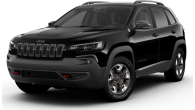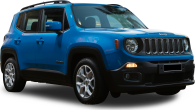A car park is a lot like a dog park. Each contains a variety of personalities, from cranky and slothful to bright and engaging. Small, medium and large. Fast, slow and everything in between.
How about these canines and their automotive equivalents? British Bulldog - Land Rover Defender. Golden Retriever - Toyota Camry Hybrid. Greyhound - Ferrari 296. And the Jack Russell Terrier? A Suzuki Jimny, of course.
Compact, up for anything, a bit bouncy at times, but hard to resist in terms of its energy, charisma and sheer willingness to please.
Since its local launch in 2019 the current Jimny has become a cult classic and a sales hit for Suzuki. In fact, an indefinite pause on customer orders for the automatic version of the three-door GLX we’re testing here was the result of an ever-lengthening waiting list.
And that’s with order books already open for the upcoming five-door version, due to arrive in Australia later this year.
So, what’s it all about? We know from previous CarsGuide testing this diminutive 4WD can mix it with the big names off-road.
But what about the urban jungle where many of these cute-as-a-button 4x4s will spend their working lives? Let’s jump in and see how it goes on-road, and in town.
Suzuki Jimny 2023: GLX
| Engine Type | Inline 4, 1.5L |
|---|---|
| Fuel Type | Unleaded Petrol |
| Fuel Efficiency | 6.9L/100km (combined) |
| Seating | 4 |
| Price From | $32,890 - $39,160 |
| Safety Rating |
|
Price and features – Does it represent good value for the price? What features does it come with?
At $31,990, before on-road costs, it’s hard to put the Jimny GLX manual in market context because there’s nothing else like it on sale here.
It might be compact and quirky, but under the skin the Jimny is a professional grade 4x4 sitting on a full ladder-frame chassis, with rigid axles front and rear, putting similarly sized AWD ‘soft-roaders’ to shame.
Some come close on price, like the Mazda CX-3 Maxx Sport AWD ($29,510), Subaru Crosstrek ($34,990) and Toyota C-HR GXL ($32,915), but none of them have that off-road firepower up their sleeves.
.jpg)
However, rock-crawling, river-fording ability isn’t the priority in the urban context, unless you live in a really rough part of town.
So, the specification counts for a lot here, and the Jimny is closer to the foyer than the penthouse when it comes to included features.
Aside from the safety and driving tech covered later, boxes ticked on the standard equipment list include, climate control air, cruise control, a 9.0-inch multimedia touchscreen, Android Auto, Apple CarPlay and Bluetooth connectivity, a leather-trimmed steering wheel, auto LED headlights, front fog lights, a reversing camera, 15-inch alloy wheels and tinted rear glass.
Not bare bones, but not the height of luxury, either. A reminder that a decent chunk of the Jimny’s purchase price buys you the car’s off-road ability.
Design – Is there anything interesting about its design?
This fourth-generation Jimny continues the little Suzuki’s upright, high-riding stance with design details borrowed from previous iterations, like the five vent grille, wide-eyed circular headlights (with round indicators close by) and chunky wheel arch extensions.
It’s almost impossible not to smile when you’re walking towards the car, especially when its boxy form is finished in our test example’s hi-vis ‘Kinetic Yellow’ colour.
And Suzuki will sell you any number of accessories to further dial up the car’s ‘can do’ attitude. Everything from grilles, bumper trims and rims to different racks, audio options, diff guards and bash plates.
.jpg)
Although, it must be said, our test car came fitted with a roof rack kit ($533.84) which, while enhancing utility, didn’t exactly do wonders for wind noise on the freeway.
Inside, the look is similarly rugged with a technical, Lego-like ‘piece A clicks into piece B’ design approach. Body colour painted sections fit with the no-frills design.
Allen head fixings for grab handles on the dash and doors, as well as dials, switches and instruments that look like they’ve come straight out of an army supply catalogue enhance the functional feel.
And that’s not just aesthetic. Simple is good, and everything works well together.

Practicality – How practical is its space and tech inside?
At just under 3.5m long (a touch over 3.6m including the rear door-mounted spare wheel), only 1.65m wide and a little more than 1.7m high the Jimny is right-sized for the city. But what do those compact dimensions mean in terms of practicality?
First of all, headroom (for me at 183cm) is good, front and rear. The Jimny is tall relative to its overall size and there’s a generous gap between my bonce and the headliner.
Put a full-size adult in the front passenger seat, though, and you’re 100 per cent aware of their presence from behind the wheel. Not cramped but cosy is the best way to describe it. And it’s worth calling out the steering wheel only adjusts for rake, not reach. Ugh!
Access to the rear seating (for two) is via a fold-and-slide mechanism for the front passenger seat and a reasonable degree of flexibility and athleticism is required to gain entry back there.
.jpg)
Once in place, adequate legroom requires negotiation with those in the front. Sitting behind my driving position, knee room is tight.
Shoulder room is at a premium, too. So, best to reserve the rear for occasional adult journeys, although up to teenage kids will be fine.
Loading in a baby capsule will be a pain due to the confined space and front-only access. However, a car seat for toddlers, once set up, won’t be too bad.
Storage is pretty scarce with only a small slot between the front seats (rather than the now customary lidded box) with two cupholders behind it, an oddments tray in front of the gear lever, a small glove box and an open tray above that.
There are bins in the doors but they’re mighty slender, and you can forget about sliding a bottle of any decent size in there.
.jpg)
Back-seaters will have to fight it out with those in the front for access to the centre console cupholders, because there’s nothing else for them. Not even map pockets on the front seat backs.
Power and connectivity runs to a single USB-A port up front with 12-volt outlets in the dash and boot.
Speaking of which, with the rear seats upright there’s 85 litres of boot space available, which is enough for one or two school bags or a couple of bags of groceries.
A narrow, removable lidded box, running the width of the load space behind the rear seats is handy for things like muddy hiking boots or wet gear after a beach trip.
With that box removed we were able to fit the smallest 36L suitcase from our three-piece set, with room to spare on either side.
Lower the 50/50 split-folding rear seat and you have 377 litres at your disposal, which is enough to easily swallow the full luggage set (36L, 95L, 124L) or the bulky CarsGuide pram.
The pram would also fit with only one rear seat down so there’s room for your baby, and related paraphernalia, too!
Worth noting the rear seat backs are covered in a tough plastic for when they’re lowered down to form the flat load floor, there are multiple bag hooks and tie down anchors to keep large and small loads under control, and the side opening cargo door swings the ‘right’ way for our ‘park on the left’ market. That is, handle on the left, opening to the right.
If you want to hook up the tinnie or a modest box trailer the Jimny is rated to tow 350kg unbraked and 1.3 tonnes braked. Plus, a 15-inch alloy spare is proudly attached to the rear door.
Under the bonnet – What are the key stats for its engine and transmission?
The Jimny is powered by a 1.5-litre, four-cylinder petrol engine pushing a relatively modest 75kW/130Nm through (in this case) a five-speed manual gearbox into Suzuki’s ‘AllGrip Pro’ part-time 4WD system.
The set-up is built around a transfer case between the front and rear axles which allows drive to easily go from the front wheels only to all four, in high- and low-range modes. More on that in the driving section.
A four-speed automatic Jimny GLX was available until mid-January this year when Suzuki Australia paused sales “until further notice” because the back-order queue had grown so long.
.jpg)
Efficiency – What is its fuel consumption? What is its driving range?
Suzuki’s official fuel economy number for the combined (ADR 81/02 - urban, extra-urban) cycle is 6.4L/100km, the 1.5-litre four-cylinder emitting 146g/km of CO2 in the process.
Over a week of city, suburban, and some freeway running we averaged 6.9L/100km (at the pump), which lessens the bowser-shock many drivers have been suffering in recent years. Interestingly, the car’s on-board computer indicated 7.0L/100km for the same period.
Minimum fuel requirement is 91 RON ‘standard’ unleaded, or E10, and you’ll need just 40 litres of it to fill the tank.
Using the official number, that translates to a range of around 625km, which drops to just over 580km using our real-world figure.
.jpg)
Driving – What's it like to drive?
At 1075kg the Jimny is not only small, it’s light, too. But 75kW/130Nm from its 1.5-litre, four-cylinder petrol engine isn’t a monumental amount.
In short, this little 4WD isn’t what you’d call quick - expect 0-100km/h in around 12 seconds - but in the lower ratios the high-range gearing, in two- or four-wheel drive, is such that it has enough get up and go for tight city and suburban running.
The gear change is smooth and positive, while the clutch is nice and light. However, multiple intermeshing gears in the gearbox and diffs generate a low-level but noticeable whining noise. At the same time the engine’s hardly a model of quiet refinement.
Speaking of multiple gears, the Jimny offers ‘2H’ (2WD-high gear), ‘4H’ (4WD-high gear) and ‘4L’ (4WD-low gear).
.jpg)
If you’re hitting a loose dirt road, or dealing with snow and ice, the change from 2H to the extra security of 4H is possible on the move up to 100km/h.
Engaging low-range 4L, suitable for the really tough off-road stuff, means coming to a full stop.
As mentioned earlier, the Jimny features a rigid axle front and rear, just like the grown-up 4x4s. And despite coil springs all around it bumps and bounces over typically pock-marked city and suburban surfaces.
The steering is light but accurate with good road feel and a tight 9.8m turning circle makes U-turns and parking a breeze. Cramped street parking? Squeezy apartment or shopping centre spots? No problem.
.jpg)
But once you slip into that coveted spot, remember to leave enough room for the side-opening cargo door, if you need to access the boot.
The Jimny’s light weight and reasonably modest towing specs mean braking doesn’t need to be heavy duty, and solid discs at the front and drums at the rear do a good job.
Under the heading of miscellaneous observations, the accessory roof racks fitted to our test car supercharged wind noise at anything above 50km/h, and overall the Jimny doesn’t feel like a substantial car.
On that last point, you might say, well, it’s small and light, so no surprise. But it’s the way the door clangs when you shut it, the ultra-functional design, the analogue feel of the controls. You’ll either love it (as so many people do) or not so much.
Warranty & Safety Rating
Safety – What safety equipment is fitted? What is its safety rating?
Safety is something of a sore point with the Jimny as it received only three out of a possible five stars when it was assessed by ANCAP soon after the car launched in 2019.
Then ANCAP CEO, James Goodwin said, “The Jimny misses the mark with structural and design weaknesses, poor protection of pedestrians and cyclists, and lack of effective safety aids."
That ‘safety aids’ reference relates in part to the Jimny’s AEB system, which received a plus for its inclusion, but not full points because it wasn’t considered effective enough.
On the plus side, Child Occupant Protection scores were high. There are top tethers and ISOFIX anchors for both rear seat positions.
.jpg)
But other shortcomings relating to the standard lane departure warning and lane keeping assist systems didn’t help the Jimny’s cause.
Plenty of features are absent, too. For example, no blind-spot monitoring, rear cross-traffic alert, adaptive cruise control or speed sign recognition.
There are six airbags on-board (driver and front passenger - front and side, and full-length side curtains), but even there the Jimny didn’t impress the ANCAP engineers, with the driver’s bag marked down for insufficient inflation, allowing the driver’s head to impact the steering wheel in the standard 64km/h frontal offset impact test.
Ownership – What warranty is offered? What are its service intervals? What are its running costs?
Suzuki covers the Jimny with a five-year/unlimited kilometre warranty, which is the current market standard. Roadside assist is included, on the proviso that your car is serviced at an authorised Suzuki dealer.
Speaking of which, the recommended service interval is 12 months/15,000km, and the average annual cost for each workshop visit, for the first five years, is $453.
Not an outrageous figure, but when you consider the similarly-priced Toyota Yaris Cross GXL is just $250 to service annually for the first five years, it’s not exactly cheap, either.
.jpg)
Verdict
On paper, the Jimny struggles as a purely urban proposition. It just gets over the line in terms of standard spec for the money, it’s not particularly practical or powerful, safety is a sizable question mark, and even servicing costs are off the segment pace.
But just like that little terrier, ready to chase a ball (or rabbit!) from sunup to sundown, its strength and enthusiasm are almost irresistible. Its size is just right, it’s pleasingly economical, and crazy cute to look at.
It’s a classic case where the head may say no, but the heart is prone to overrule with an emphatic yes.
Pricing Guides

Range and Specs
| Vehicle | Specs | Price* |
|---|---|---|
| GLX | 1.5L, Unleaded Petrol, 4 SPEED AUTOMATIC | $32,890 - $39,160 |
| GLX (qld) | 1.5L, Unleaded Petrol, 4 SPEED AUTOMATIC | $37,950 - $44,660 |
| XL | 1.5L, 4 SPEED AUTOMATIC | $34,760 - $41,360 |



.jpg)

.jpg)
.jpg)
.jpg)
.jpg)
.jpg)
.jpg)












































 copy.png)














.jpg)
.jpg)
.jpg)
.jpg)
.jpg)
.jpg)
.jpg)




Comments